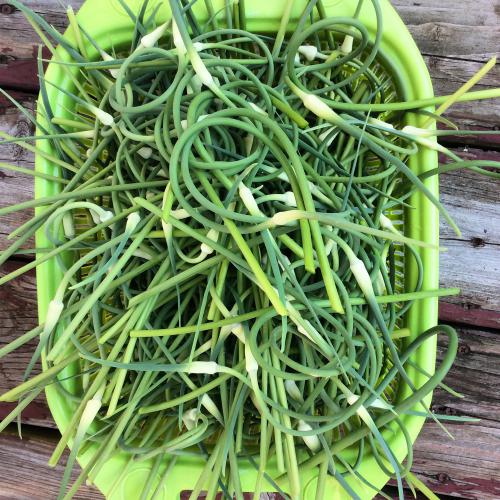Fall is the time to enjoy and plant Michigan garlic
Michigan State University Extension's Michigan Fresh garlic provides safe handling and storage tips.

Fresh garlic bulbs are a kitchen staple that can easily be grown or found at your local farmers market. Most garlic bulbs are harvested in July and August but can be found year round at farmers markets as a storage crop. There are two categories of garlic: hard neck and soft neck. Soft neck garlic bulbs tend to have smaller cloves and a milder flavor. They can be a bit hard to peel, but the soft stalk (“neck”) makes them ideal for braiding and hanging for storage. YouTube has plenty of video tutorials on how to braid garlic for those looking for a visual aid. Hard neck garlic have larger cloves that are easier to peel. Hard neck varieties also produce a stiff central stalk called a scape. Garlic varieties that MSU variety trials have shown to grow well in Michigan include German white and Music (hard neck varieties) and Polish (soft neck variety).
If you would like to try growing your own garlic, now is the time to start planning your garden. Garlic is planted in the fall, ideally six weeks before the ground freezes. Depending on your location in Michigan, this is generally sometime in October. You can find out more specifically by visiting the MSU Enviro-weather website. As with any type of garden, it’s a good idea to start with a soil test to find out the soil pH and nutrient availability. Garlic prefers a soil pH of 6.5-7 and acidic soils can cause the plants to die. Garlic bulbs are usually ready to harvest in July or August, when 30 to 50 percent of the leaves have died back.
Whether you grew your own garlic or purchased it from a local farmer, proper storage will ensure that your garlic stays safe and delicious. Fresh garlic will keep for about a month under proper conditions. Breaking the bulb will decrease its shelf life. Discard or do not purchase bulbs that have soft or shriveled cloves, or cloves with green shoots. Store fresh garlic in a cool, dark place either uncovered or covered loosely. Canning and freezing are not recommended for garlic. Garlic can be preserved in oil and stored in the refrigerator for one week or in a jar in the freezer with half an inch of headspace for several months. It is not safe to keep garlic oil at room temperature as botulism can develop. Garlic can also be preserved by peeling and finely chopping cloves and then drying in a dehydrator for six to eight hours.
As you plant your garlic this fall or start daydreaming about next year’s farmers market, there are two other less well-known garlic products to look forward to in spring and early summer. Garlic scapes and green garlic can be harvested from the garlic plants in your garden or found at your local market.
Garlic Scapes. Photo by Mariel Borgman
Garlic scapes are the stiff central stalk produced by hard neck garlic varieties. This stalk emerges from the garlic plant early in the summer (usually mid-June) and begins to curl as it grows, before eventually straightening out again to form the garlic “flower.” This is not a true flower, but bulbils that are clones of the garlic plant. Harvest scapes while they are curled by breaking, cutting, or pulling them from the plants. Be careful not to pull the plant out of the soil when pulling scapes! Producing scapes and bulbils takes quite a bit of energy, so harvesting the scapes from garlic plants allows them to concentrate their energy on bulb production, resulting in larger bulbs. This is a “win-win” for the chef and the plant, as garlic scapes are delicious added to stir-fry dishes, roasted, or pickled.
Green garlic is the term for garlic plants that have been harvested prior to producing bulbs. In Michigan, this harvest can happen as early as late April. Try using green garlic as you would green onions in culinary creations.
The Michigan Fresh Garlic factsheet can be accessed at: http://msue.anr.msu.edu/resources/michigan_fresh_garlic. Michigan Fresh helps people explore the state’s bounty of fresh, locally grown fruits, vegetables, meats and more. Find factsheets plus much more information on our website: http://msue.anr.msu.edu/program/info/mi_fresh. You can also find and follow Michigan Fresh on Facebook, Pinterest and Instagram.



 Print
Print Email
Email



